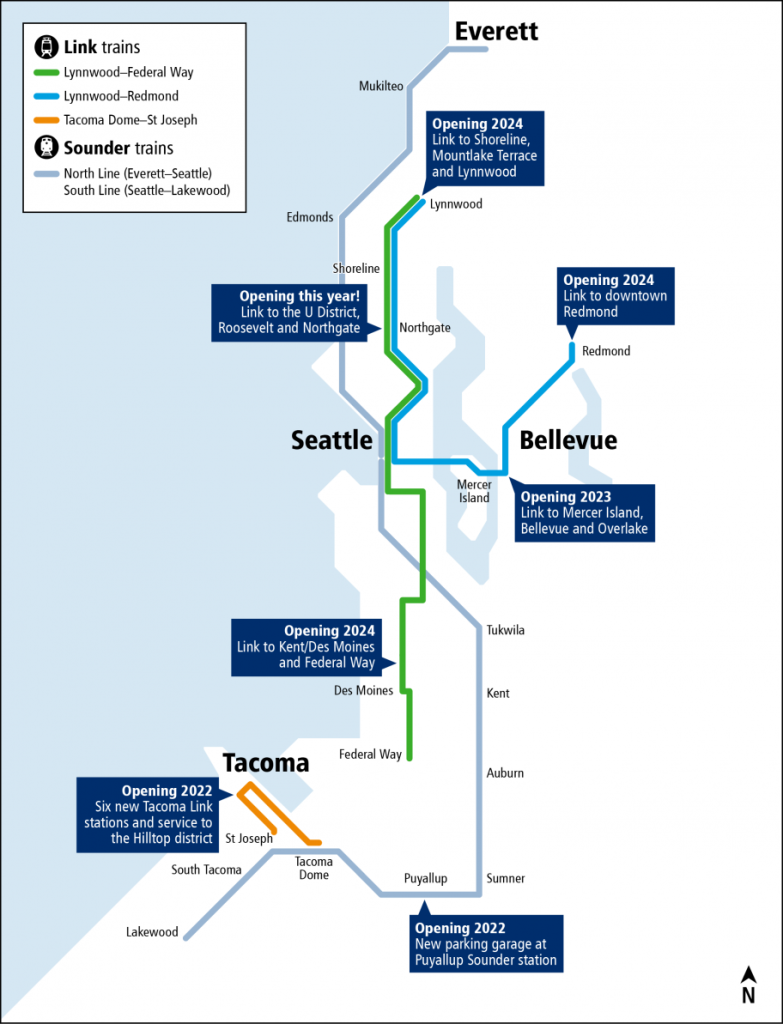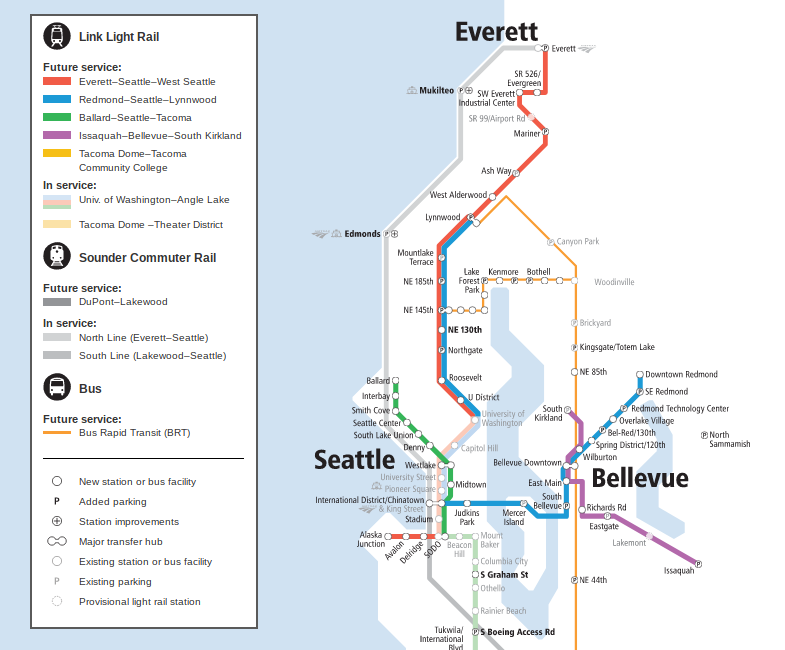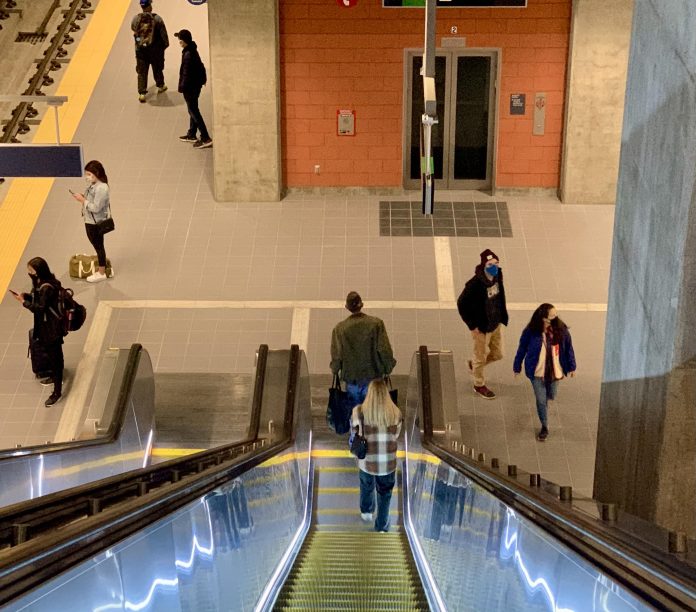
The history of Link light rail was writ large on the Northgate Link’s opening day.
The entry point for my first ride to Northgate Station on Link light rail was Capitol Hill. It was early in the morning on the opening day, although so not as early as I had hoped, my plan to be on the first departing train at 4:51am proving too ambitious. Yet it was not too early for Erica Clausson, a wheelchair user who lives in the Licton Springs neighborhood near the west end of the John Lewis Memorial Bridge. Very enthusiastic about the newfound mobility the light rail expansion would bring into her life, Clausson may have been the first light rail rider to use the pedestrian and cyclist bridge to safely access the Northgate Station, arriving at the station before the departure of the first train.
“My doctors are all located at the UW Medical Center, so I’ll be using light rail a lot to get to my medical appointments,” Clausson said.
It cannot be stated enough that when we create accessible, affordable, climate friendly mass transit, we transform people’s lives for the better. Clausson is one example of the many people whose lives will improve as a result of the arrival of the Northgate light rail expansion. In my discussions with early morning riders on the first day of service, I encountered airport travelers, hospital workers, people heading to set up their farmer’s market stalls, grandparents meeting family in the International District for dim sum, and a little boy dressed up as a firefighter whose father was touring him around the new light rail stations.
We are standing quite literally at the precipice of a mass transit revolution in the greater Seattle area. The openings of the Tacoma Hilltop Extension (2022), East Link Extension (2023), and Lynnwood Extension (2024) are all around the corner. Further expansion plans passed with Sound Transit 3 (ST3) measure in 2016 have been kept mostly on track with a hybrid realignment plan that preserves planned stations and avoids major delays even facing some big jumps in project cost estimates. Plus, Seattle Subway is pushing its vision for Sound Transit 4 (ST4) expansion. There is so much more rapid transit coming, including 25 stations in the next three years.
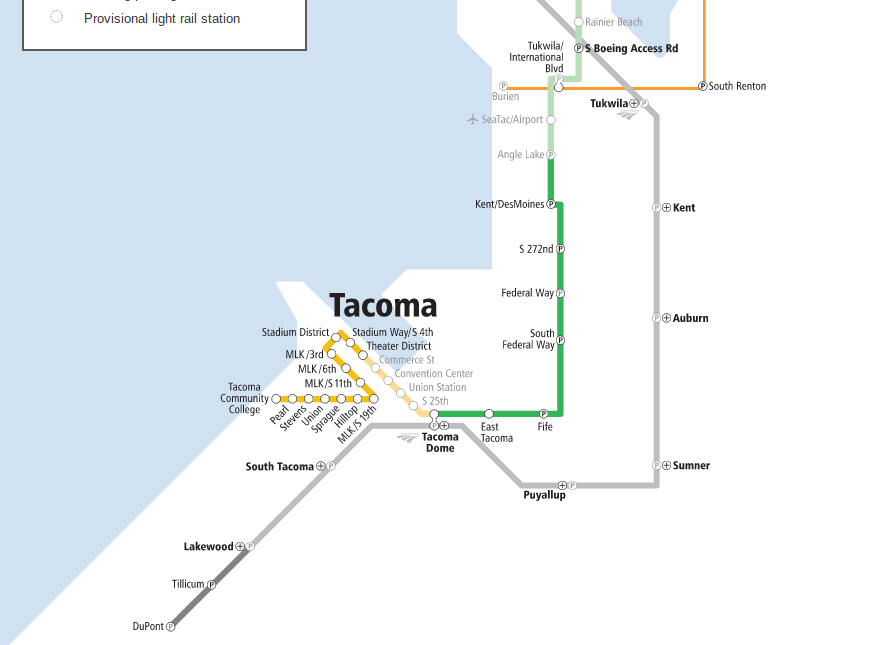
At this moment in time, there is arguably no urban area in U.S. that is as hungry for new mass transit as Seattle. That’s why as soon as The Urbanist came into being, regional light rail expansion soon became one of our biggest areas for writing and advocacy. Related to the Northgate expansion alone, we have published approximately 40 articles — many more if you can consider ancillary topics like updates to Sound Transit station wayfinding, and the rollercoaster ride that surrounded securing funding for Sound Transit.
Northgate Link has finally arrived. As we celebrate this moment, let’s take a look back at what it has taken the greater Seattle region to get here. It’s story full of disappointment, twists, achievements, and most of all, unwavering belief that mass transit has a place at the center of our regional transportation system.
From the iron age, to the golden age of mass transit in greater Seattle
“If this is the golden age of light rail, I’m from the iron age,” joked Greg Nickels, former mayor of Seattle and King County Councilmember, in a recent event hosted by the Transportation Choices Coalition (TCC) in which Nickels, and current Sound Transit board chair Kent Keel, spoke about the past, present, and future of the Link light rail system.
Nickels, who made creating a regional mass transit system a pillar of his successful run for King County Council in 1987, never imagined he would end dedicating much of his professional life to Sound Transit. “I suppose if I had known that [light rail] would occupy all 22 years of my public life, I may have had second thoughts –- but when I saw those first stations open, I knew it was worth it,” Nickels said.
But it would take decades to arrive at that moment. Both the failure of the rail plans included in the two Forward Thrust ballot measures of the late 1960s, and the even better known doomed Monorail expansion, which still haunts Seattle lawmakers today in the form of a state bill restricting Seattle from being able to independently raise revenue for grade separated rail transit unless it funds a monorail project, cast a pall over mass transit expansion efforts.
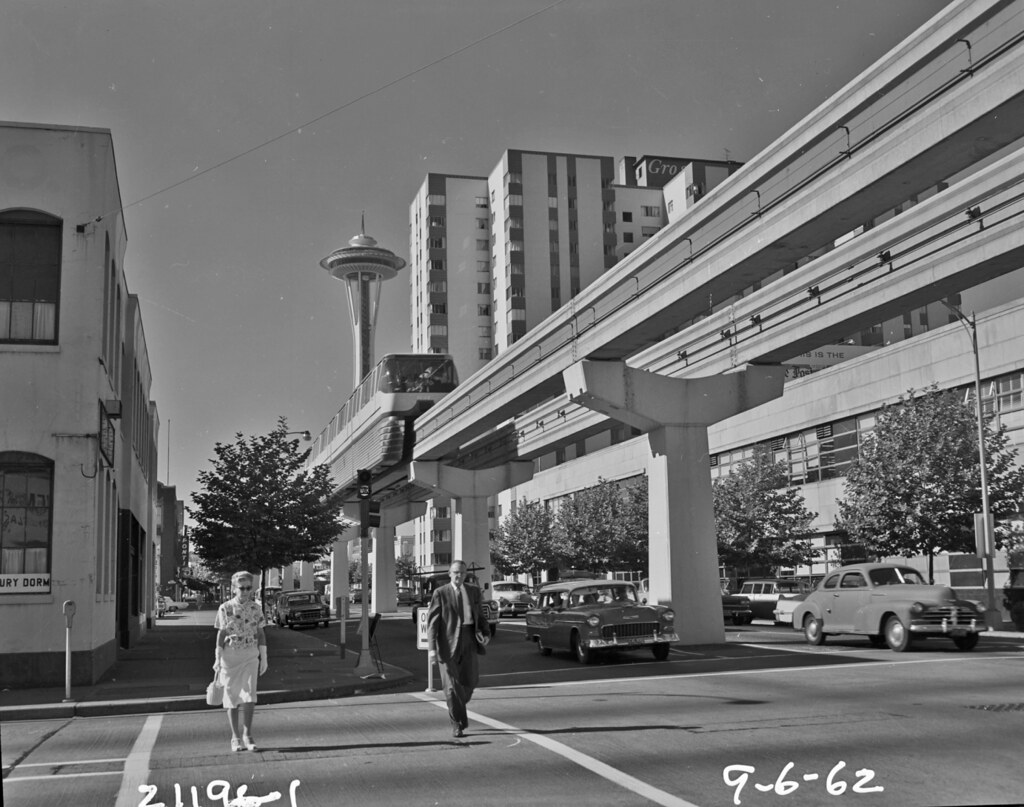
As a result of those defeats, enthusiasm for mass transit lagged until 1988, when Nickels co-sponsored an advisory measure asking voters if they wanted light rail. Nearly 70% of voters said yes, creating new political momentum for regional rail transit.
However, that did not mean smooth sailing lay ahead. It would take years for a regional rail measure to be presented to voters, and it would fail. In 1995, only a year before voters would approve the Sound Move ballot measure that would jumpstart the creation of Sound Transit, voters rejected a $6.7 billion regional transit plan put forth by the Regional Transit Authority, the agency’s precursor.
The plan would have constructed many transit system elements recognizable today including:
- Light rail rapid transit lines from Tacoma to Seattle and north to Mill Creek via the University District, Northgate, and Lynnwood. Light rail was also planned to cross the I-90 bridge to Bellevue and reach Redmond;
- standard-gauge commuter rail service from Everett to Tacoma;
- expanded HOV (High Occupancy Vehicle) lanes on major freeways;
- a new express bus system.
The more ambitious regional transit measure actually won majorities in Seattle, Mercer Island, and Shoreline, but could not overcome resistance from the Eastside of King County, as well as Pierce and Snohomish counties.
Contemporary critics promoted an alternative plan called the Rhododendron Line, a grade level rail system that would have run on north, south, and east corridors, connecting Seattle to Everett, Tacoma, and Bellevue. The Rhododendron Line had the financial advantage of using existing right of way, but it was projected to have low ridership as a result of slow speeds and a lack of service to major destinations like First Hill and the University District in Seattle. Other critics, notably in the Eastside, preferred a less costly system centered on prioritized transit lanes for buses.
Additionally, residents of Everett were so offended by the proposal’s omission of a light rail connection to Everett, that according to Nickels, the plan proved to be “even less popular than prohibition” in the city.
Voters did approve the scaled back $3.9 billion Sound Move measure the following year, showing there was support for rail, though not at the ambitious scale, or expense, of the previous proposal. The 1996 Sound Move measure included the creation of 22 miles of light rail, with a line extending from Seattle-Tacoma International Airport through Seattle to the University of Washington and a separate 1.6 mile line from the Tacoma Dome to downtown Tacoma. Work was supposed to be completed by 2006, although the light rail service would not reach the University of Washington until 2016, where it opened with great fanfare, significantly increasing Seattle’s light rail ridership and putting us on the path to the “golden age” of mass transit for the region which we are entering into today, 25 years later.
Looking back at what it took to arrive at this moment, Nickels was ruminative, acknowledging the challenges and setbacks that occurred along the way.
“You have to learn that you can’t make everybody happy — even when it comes to good ideas. It isn’t fun to have to say no, particularly when you have this grand vision and you have to bring it back to being possible to get it done,” Nickels said. “I didn’t agree with all the decisions made, no one does, but I appreciate the work we did.”
Transit oriented development, an unforeseen game changer
As I entered the Capitol Hill Station early in the morning of the Northgate Extension’s opening day, the streets surrounding the station were quiet — yet, not as quiet as they had been before the introduction of over 428 homes, 176 with affordable rents, through transit oriented development project at the Capitol Hill light rail station. Anyone familiar with Capitol Hill can feel the dynamism these new homes have injected into the neighborhood — streets are more active with people throughout the day, but especially at night. What has always purported to be one of Seattle’s most urbanized communities finally feels like it earned the reputation.
Nickels, who moved to Capitol Hill as a middle schooler and whose parents continued to live in the neighborhood for many years, was especially proud of how the introduction light rail meant that Capitol Hill residents could “avoid having to drive that I-5 nightmare.”
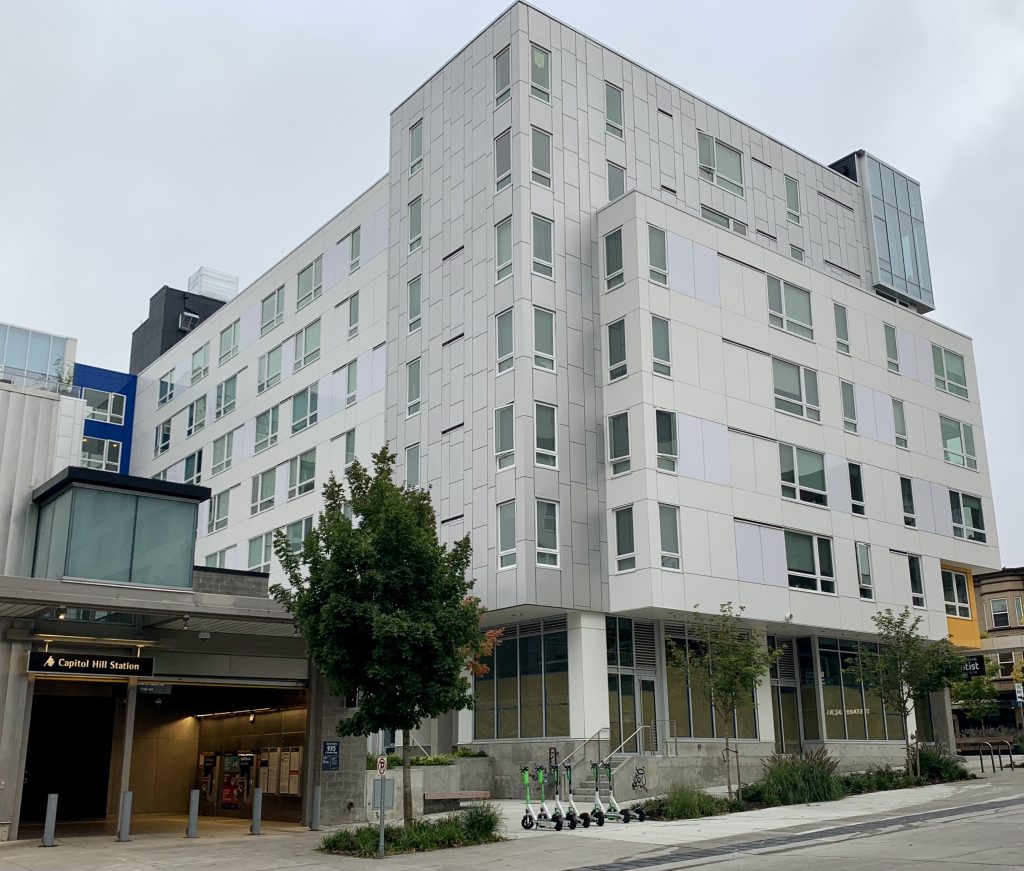
However, when Sound Transit first set out to construct Link light rail, planning for housing and commercial investments near light rail stations was barely an afterthought. “When we started we didn’t have a good sense of how to connect transportation planning with land use planning,” Nickels admitted. But that awareness changed as the region continued to engage in Growth Management Area (GMA) planning, and by the time Nickels became mayor of Seattle in 2002, the City of Seattle in particular was beginning to plan for density around light rail stations.
That shift in perspective has resulted in a radically different approach today, one which prompted current Sound Transit board chair, Kent Keel, to joke that he feels he is equally engaged in housing as transit development. Keel also acknowledged, however, the constraints his agency confronts around ensuring density near light rail stations. “Upzoning is a city effort. At Sound Transit, we have almost no control over that, ” Keel said. “Of course transit most successful in my mind with density – we need density and walkable communities near transit.”
Keel said that while the Seattle neighborhoods of Roosevelt and and U District “rolled out the welcome mat” to both light rail and density, some of the “most aggressive zoning changes” have occurred in regional cities like Kent and Lynnwood. “I’m anticipating to get the same kind of reaction from Tacoma and Everett,” he said.
Covering transit oriented development has been one of our major focuses in our writing for The Urbanist, from the new development surrounding the U District, Roosevelt, and Northgate light rail to stations, to major transit oriented development projects like Bellevue’s Spring district.
Earlier this year, Stephen Fesler reported for The Urbanist that Sound Transit had announced it would provide at no cost to the city ten properties for affordable housing development in Seattle’s Rainier Valley. One hundred percent of the homes created on the sites will need to affordable to rent or own by households earning at or below 80% of the area median income level — a requirement that will remain in place for 50 years.
Thus the sea change of thought surrounding the coupling of transit and housing development continues onward.
Accessible transit for people with disabilities
When Nickels was asked what accomplishments he was most proud of during his time advancing regional mass transit, he cited the Seattle region’s reputation for creating mass transit accessible for people with disabilities as rising to the top. According to Nickels, years ago while attending a conference for American and Canadian transit agencies, disability activists chained themselves to the building to block attendees from entering in order to raise awareness of transit agencies’ failure to meet the needs of disabled people. However, when Nickels said he was representing King County Metro transport, they let him pass through in recognition of Metro’s commitment to accessibility.
Nickels said the same ethic of prioritizing the needs of disabled transit riders was present at Sound Transit, a statement that Keel, who shared that he has an adult daughter who uses her wheelchair for transportation, agreed. “It should be obvious that at a minimum we need to comply with all ADA requirements. We have a disability mobility committee that provides feedback and we will continue to work in consultation and negotiation with them and our host jurisdictions on how we implement and do our work around ADA,” Keel said.
Those statements bring me back to Erica Clausson, the wheelchair user who I interviewed early in the morning on the Northgate expansion’s opening day. Today Clausson, and many other people with diverse wants and needs regarding transportation, are benefitting from the expansion of light rail service. In a couple more years, those benefits will multiply with arrival of the East Link and Lynnwood Extensions.
The history that has led the region to this point has not always been easy; and especially in the face of the housing affordability and climate crises, it can be painful to look back at all the opportunities missed along the way. Still even in the face of what has often been an uphill battle, light rail has continued to expand in the Seattle region. Most of all, hope remains that the lessons of the past can help us arrive at an even better regional mass transit system in a not so distant future.
Note: This article was corrected to remove a reference by Greg Nickels criticizing highway spending in the 1995 transportation funding ballot measure. In his remarks for Transportation Choices Coalition, Nickels referred to a 2007 transportation measure that was also rejected by voters.
Natalie Bicknell Argerious (she/her) is a reporter and podcast host at The Urbanist. She previously served as managing editor. A passionate urban explorer since childhood, she loves learning how to make cities more inclusive, vibrant, and environmentally resilient. You can often find her wandering around Seattle's Central District and Capitol Hill with her dogs and cat. Email her at natalie [at] theurbanist [dot] org.


